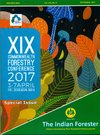Socio-Economic Potential and Marketing Trend of Bamboo in Mizoram: A Case Study from Aizawl District
DOI:
https://doi.org/10.36808/if/2017/v143i9/118871Keywords:
Bambusa tulda, Melocanna baccifera, Schizostachyum dulloa, Bamboo Culm, Socio-Economic.Abstract
Bamboo plays an important role in the socio-economic life of rural as well as urban people. Due to its varied uses including construction of houses, huts along the roadsides for selling agricultural produce, household articles, fencing, agricultural implements, cultural implements etc. The present study was done to evaluate the pools and fluxes of bamboo culms in Aizawl and its value added products obtained in the study area. Data were collected among the bamboo entrepreneurs in the local markets using PRA and survey was conducted in three strata viz. retailer, industry and consumer level. Among all bamboo species Bambusa tulda was the most common species found in the market although Melocanna baccifera dominates among bamboo species that contributes about 95% of the growing stock in the state. Schizostachyum dulloa being the most preferred species due to its long internode and flexibility for making export products. The price of one bundle of bamboo culms varies from ` 170-200/- whereas the price of dap (flattened bamboo) varies from ` 200-250/-. The total weekly turnover of bamboo culms market in the city was ` 487,250.00/- in which 2,685 bamboo culms supplied and 1,466 bundles sold weekly. The study also reveals that bamboo culm markets provide employment for 27 male and 25 female that gives a total of 52 persons in the study area. The findings of the study will help to assess the trends of bamboo culms in the market, its socio-cultural and economic importance provided by bamboo resource in Aizawl district and the state as a whole.References
Anon. (2010). Bamboos of Mizoram. Environment and Forest Department, Govt. of Mizoram, Aizawl
Banik R.L. (1993). Morphological characters for culm age determination of different bamboos of Bangladesh. Bangladesh J. Forest Science. 22(1&2): 18-22
Das A.N. (1999). Socioeconomics of Bamboos in Eastern Nepal. PhD Thesis, University of Aberdeen, UK
Das A.N. (2004). Manual on Bamboos of Nepal. Community Forestry Component. Tree Improvement and Silviculture, Ministry of Forest and Soil Conservation, Kathmandu, Nepal
FAO (1978). Bamboo forest news for Asia and the Pacific. Food and Agricultural Organizations, Bangkok, Thailand
FAO (1990). Case studies in forest based small scale enterprises in Asia: Rattan, Matchmaking and Handicrafts. Campbell Jeffery (Ed.). Community Forestry Case Study No. 4. FAO, Bangkok, Thailand
Kattel A., Parajuli B. and Tuladhar G.R. (2007). A Study of the Bamboo and Rattan Sub sector in Eight Municipal towns and Surrounding Areas of Nepal. INCON Pvt. Ltd., Lalitpur, Nepal
Liese W. (2009). Bamboo as Carbon-sink – Fact or Fiction? J. Bamboo and Rattan. 8: 103-114
Shanmughavel P. and Francis K. (2001). Intercropping trials of four crops in plantations. J. Bamboo and Rattan. 1(1): 3-9
Singhal R.M. and Gangopadhyay P.B. (1999). Bamboos in India and Data base. ICFRE, Dehradun. 1-147 pp
Stapleton C. (1994). Bamboos of Nepal: An Illustrated Guide. Royal Botanical Gardens, Kew, London, UK
Tewari D.N. (1992). A Monograph on Bamboos. International Book Distributors, Dehradun.
Vanlalfakwama D.C., Lalnunmawia F. and Tripathi S.K. (2014). Estimation of Biomass of Three Major Bamboo Species of Mizoram, India. In: Issues and Trends of Wildlife Conservation in Northeast India. (Eds: Lalnuntluanga, Zothanzama, J., Lalramliana, Lalduhthlana, Lalremsanga, H.T.). Mizo Academy of Sciences Aizawl, India. 151-156 pp.
Downloads
Downloads
Published
How to Cite
Issue
Section
License
Unless otherwise stated, copyright or similar rights in all materials presented on the site, including graphical images, are owned by Indian Forester.





